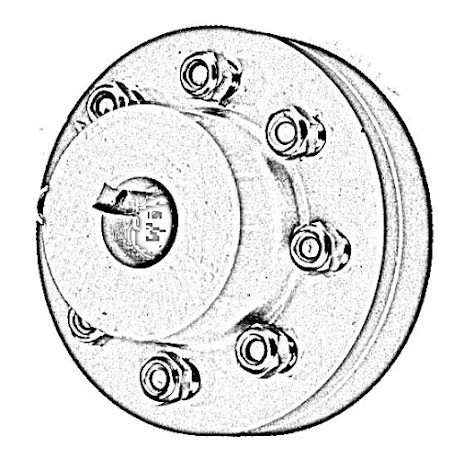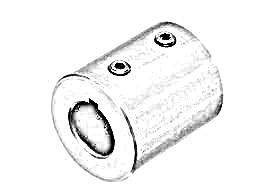What is rigid coupling?
Rigid coupling
Rigid coupling is used only whenever the misalignment between equipment shafts is very less or no misalignment is present in the system. When the equipment is appropriate to carry the reactionary load produced from trying to flex rigid couplings. This type of coupling mostly prefers for vertical applications such as vertical pump. In those cases, rigid couplings are a very effective means of connecting machine shafts. But the rigid couplings used to connect two shafts of two rotating equipment and that allow transmitting power and torque from one machine to another machine. That also can be used if machines that have shafts of different sizes.
That couplings should be used only when the both equipment shaft does not have misalignment and when the shafts of the machine and the rigid coupling are long enough that accept the forces and moments produced by the mechanical shaft deflection on these.
Rigid coupling dimensions, the dimension is also a measure factor during the selection of best suited of coupling for your machinery. Because the rigid coupling used where very less dbse required because spacer does not use with this type of arrangement. The shaft alignment is very less. For rotating machinery, when two machine shafts are connected rigidly and properly, then both machines operate as a single shaft.
What is flexible coupling
What is the use of rigid couplings?
Use of rigid coupling
Rigid couplings are use as shell or flange type. That are used where journal or thrust bearing is not provided for the pump or the motor shafts, as is often the case with vertical pumps
There are two type of couple system used to connect, two different machine shaft, these are direct and indirect coupling. The main problem associated with directly coupled equipment is how to compensate misalignment that will occur between two pieces of rotating equipment.
Rigid coupling example are Muff type, Sleeve type, Flange type and Clamp coupling.
What is the most common type of rigid coupling?
Types of rigid coupling
There are four basic types of rigid couplings name, and their description are mentioned below.
- The flanged type rigid coupling
- The clamp type rigid coupler
- The sleeve type rigid coupling
Flange rigid coupling
Mostly flange type rigid coupling used to connect the rotating machine if both machine shaft are already aligned to each other. And the top advantages of selecting flange type coupling is that very less expensive as compare to other type and it has also less space required to installation. One of the most common uses is interchangeable with standard flanged gear couplings. Flanged couplings are mostly prepared where there is free access available to both shafts. In some cases compression type coupling used where key and keyways not possible to use like as brass type shaft. You should have to check specification of coupling information about material to be used, bore sizes allowed with tolerance, number of bolts to be used as per flanged rating and it size, and maximum and minimum torque & speed required for operation. That can we used for verticals and horizontals application as well.
Clamp rigid coupling
This type of coupling used to connect two different machine shaft and work as a single shaft. But in this case both machine shaft should be precisely aligned to each other and used for closed couple application mostly it is available in two parts and use with same size of machine shaft. This is available come in many different shapes, sizes, and options and use in a verity of application. That is, consisted two circular metal or semi metals strip and tighten by bolts or screw.to construct this type of coupling mostly following material are used such as Low Carbon Steel Finish, Zinc Plate, cast steels.
Sleeve rigid coupling
This is the simplest type of coupling, it means that easy to install and maintainable, but this is used connect and transmit power and torque, where the same size of shaft available of both equipments. It can be slide onto the shaft of one piece of equipment to other equipment. The sleeve is fixed on to the shaft with the help of tighten the set screw. And there is no standard follow of use in this type of coupling. This will also allow transmitting large torque with taper bore on shaft and sleeve as well. There are two type of sleeve rigid coupling available in now days and both are used for different application depends on torque required to operate such as Sleeve rigid couplings with setscrews are used only for motor-driven pump whereas the hydraulic sleeve rigid coupling is used for high-torque applications only such as marine propulsion shafting.
But material selection for coupling manufacturing can lead the performance of coupling so that selection of material is the measure factor of coupling performance, following material used to construct an appropriate coupling that is aluminum alloy, stainless steel, acetal, maraging steel and titanium.
What material used to construct a flanged rigid coupling?
material used to construct a flanged rigid coupling
To construct flanged rigid coupling is various type of materials such as Gray iron, malleable iron, carbon steels, and alloy steels and carbon steel series from 1035 to 1050.
what is the difference between flexible couplings and rigid coupling ?
flexible couplings and rigid coupling
Now days in the industries there two basic types of couplings used to drive the other equipment with the help of different equipment that is rigid couplings and flexible coupling.
But in case of rigid type coupling, connect two shafts with strength, less friction loss, and high-precision hold. Whereas in flexible couplings, which is used to connect with allow slightly misaligned between shafts but it is can transfer torque as same as rigid types. But both have its own advantages and disadvantages, that is important to know which types of couplings best suited for your application. Flexible couplings can be used with small, and medium levels torque transmission with very little shaft misalignment.
How do rigid couplings and flexible couplings differ?
Difference between rigid and flexible couplings
The main difference between rigid and flexible coupling is that the connection between shaft they have provided and required to connect of equipment shaft. Rigid types are used to provide a rigid connection only, where two shafts are closely connected. Another feature is that coupling allows smoothing transmission of torque between both equipment.
As you know that Flexible coupling, create flexible connections between equipment and the components used to assemble the coupling fixed with some amount of loose, that why some amount misalignment it can absorb. But metallic flexible type has greater torque capability than other flexible couplings, and some torque will be lost during complete operation of equipment.
There are many other difference presents whose descriptions are below in details.
where are couplings used?
Applications
Flexible couplings can be used in low and medium torque levels and the allow small shaft misalignment. This is used for the following type of application likes machining tools, manufacturing equipment, and packaging equipment. Whereas Rigid couplings used for high-torque requirements with precision alignment, to connect heavy equipment support applications, and push-pull application.
Economically
Rigid types are less economically than flexible coupling, which leads appropriate selection for equipments.
Alignment Requirements
Flexible coupling allow very little misalignment between both equipment’s shafts and also allow smooth operation. Rigid types are torsionally stiff and does not allow any misalignment between equipment shaft. Due to this to both shafts are physically aligned and parts that may cause misalignment during operation due to thermal effect.
Backlash
There are theoretically no backlash present in Rigid couplings’ connection, but aluminum rigid couplings can reduce backlash to at-zero or near-zero levels due to material and machinability. Flexible couplings do not offer the protection like this. So rigid type is the best choice for Maintenance as well.
Requirements
Because rigid couplings are stiff connected and its do not absorb vibrations. That can lead to early replace parts, due to wear on the parts these aren’t properly aligned. The Operators should require to routinely check rigid couplings for wear and alignment. They should also require to regular apply lubricant. But in case of Flexible couplings, this can handle vibration and shock without adverse wear on the machine shaft.
What are advantages of rigid coupling?
Advantages of rigid coupling
Rigid couplings are used in almost any complex motion system. However, rigid couplings have many advantages that make them the best preferred choice for many projects. Some of their key advantages are concluded below you can review it.
- Rigid couplings can transfer more torque from one shaft to the other connected shaft than other types. It is High torsional stiffness that allows for better positioning.
- It is available in many varieties with less expensive than other type, it is also available at cost-effective rates markets. Precision, with zero backlash
- Rigid couplings are used to best aligned, shaft alignment between the motor and connected components is highly precision.
- That will also allow sustainability for push-pull and support applications, Easy to assemble, disassemble, and maintenance operations throughout the life of the coupling.
NEXT PART 1






